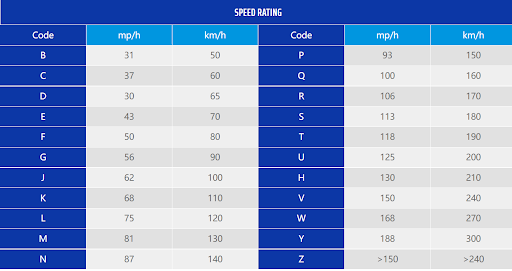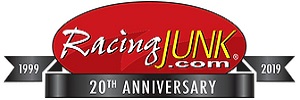Choosing the right tires is more than just picking the right size or brand. Tire speed ratings, marked by a letter, indicate the maximum speed a tire can handle. But there’s more to these ratings than just speed. They impact your vehicle’s performance, safety, and overall driving experience. Knowing what each speed rating means and how it applies to your vehicle ensures you make an informed decision for your next set of tires. This guide will explain the importance of speed rating tires, how to read them, and how to choose the best rating for your driving needs.
What Is a Tire Speed Rating?
A tire speed rating is a letter code that specifies the maximum speed a tire can safely sustain for an extended period. This rating combines with the load index to ensure your tires suit your vehicle’s performance characteristics. Automakers determine the recommended tire speed rating for each vehicle based on engineering specifications and the vehicle’s intended use. For instance, a sports car may require a high-speed rated tire to match its capabilities, whereas everyday sedans can operate safely with lower-rated tires. Understanding these ratings helps you select tires that maintain safety, optimize performance, and suit your driving needs.
Why Tire Speed Ratings Matter for Drivers
Safety and Handling Performance
Tire speed ratings are crucial for maintaining vehicle safety. Tires with higher speed ratings typically offer better handling and stability. This is because they are constructed with higher-quality materials and more advanced design techniques. When driving at high speeds or on twisty roads, the increased stability and improved handling reduce the risk of accidents. Moreover, these tires can dissipate heat more effectively, reducing the likelihood of a blowout or tire failure.
Impact on Tire Lifespan and Efficiency
While high-speed-rated tires enhance performance, they may also influence tire lifespan and fuel efficiency. High-speed tires often have softer rubber compounds for better grip, which can wear out faster under normal driving conditions. Conversely, lower speed-rated tires, made for everyday use, tend to be more durable and offer greater longevity. Additionally, the rolling resistance in higher-rated tires may be higher, slightly reducing fuel efficiency. Balancing performance demands and daily usability is key to choosing the right tire with appropriate speed ratings.
How to Read Tire Speed Ratings
Reading tire speed ratings is straightforward once you know what to look for. The speed rating is typically the last letter in the tire size code printed on the tire sidewall.
Speed Rating Letters and Their Maximum Speeds
Here’s a quick guide to the most common tire speed rating letters and their associated maximum speeds: – L: 75 mph – M: 81 mph – N: 87 mph – P: 93 mph – Q: 99 mph – R: 106 mph – S: 112 mph – T: 118 mph – U: 124 mph – H: 130 mph – V: 149 mph – W: 168 mph – Y: 186 mph – Z: 149 mph+ (for tires exceeding 149 mph)

Common Ratings and What They’re Used For
- L, M, N, P: Generally for off-road and light trucks.
- Q, R, S, T: Suitable for family sedans, vans, and light trucks.
- H: Commonly found on sport sedans and coupes.
- V: Performance tire for higher speed applications.
- W, Y: High-performance sports cars.
- Z: Ultra-high performance, used for exotic cars capable of 149 mph+.
Tire Speed Rating vs Load Index: Know the Difference
While speed ratings indicate the maximum speed a tire can handle, the load index shows the maximum weight a tire can support. Both ratings are essential for maintaining vehicle performance and safety. The load index is a numerical value that, when multiplied by four, should meet or exceed the vehicle’s maximum load-bearing capacity. Ensuring both proper load index and speed rating prevents overloading or overstressing tires, which could lead to tire failure. Always consult your vehicle’s manual to find the manufacturer-recommended ratings for optimal performance.
Can You Use a Tire With a Different Speed Rating?
When It’s Safe to Change Ratings
Changing your tire’s speed rating is not recommended but can be acceptable under certain conditions. For temporary use or fitting winter tires, dropping a speed rating one level below the manufacturer’s specification might be permissible. For example, if your vehicle typically uses an H-rated tire, temporarily using a T-rated tire for winter should be safe if driving conditions are acknowledged.
Risks of Downgrading Speed Ratings
Using tires with ratings lower than recommended for extended periods can significantly impact your vehicle’s handling, safety, and balance. Lower-rated tires may not provide the necessary grip at higher speeds or under stress, increasing the danger of accidents. Additionally, lower-rated tires may not effectively support your vehicle’s performance capabilities, leading to poor handling and increased wear. Always aim to match or exceed the prescribed speed rating to keep your vehicle operating safely and efficiently.
How to Choose the Right Tire Speed Rating
Consider Your Driving Habits
Your driving style greatly influences the tire speed rating you should choose. For spirited driving or frequent highway travel, a higher speed rating ensures stability and safety at higher speeds. If you primarily drive in urban settings with lower speed limits, a lower speed rating can suffice while potentially offering a longer tire lifespan.
Match Ratings with Vehicle Type and Use
It’s essential to match the tire speed rating to your vehicle’s type and intended use. For instance, family sedans or vans operate well with moderate speed ratings like T or H. Higher-performance vehicles should use V or W-rated tires to ensure optimal performance and safety. Always refer to your vehicle’s specifications to check the recommended ratings.
Real-World Examples: Touring, Sport, and SUV Tires
- Touring Tires: Often rated T or H; designed for balanced performance and comfort, perfect for daily drivers.
- Sport Tires: Typically V, W, or Y-rated; built for handling and high-speed stability, suitable for sports cars.
- SUV Tires: Generally come in S or T ratings; robust construction for longer wear and ability to support heavier loads while providing a good balance between performance and durability.
Conclusion
Understanding tire speed ratings is vital for making an informed decision about your vehicle’s tires. These ratings not only guide you about the maximum safe speed but also affect handling performance, safety, and tire lifespan. By considering your driving habits and vehicle specifications, you can select the right tire speed rating that enhances your driving experience and ensures safety on the road. Always consult your vehicle’s manual or a professional to find the optimal tire speed rating for your needs. Ensuring that your tires match your driving requirements can lead to better performance, safety, and efficiency.









